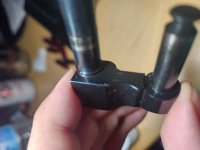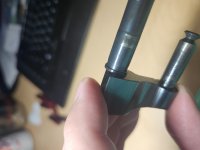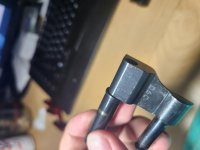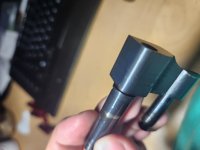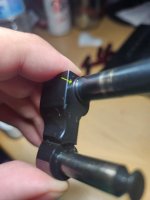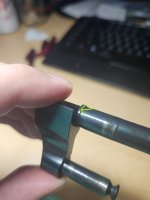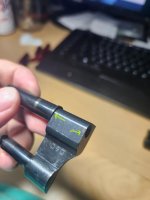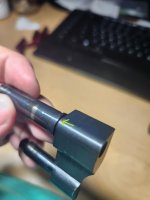I'd think the copper color is from the joining of the tube to the yoke during mfg'r.
Guessing,,but likely done with Braze and induction coil heat set up.
The process takes only a couple seconds.
The ring of copper is the tiny amt of excess solder if you can even call it that that accumulates at the visible part of the joint.
The small patch of copper color away from the joint is likely from spatter when the joint was soldered.
Just my guess of course, but that's what it all looks like judging from what I've seen done and have done on other firearms.
The copper color comes from the clean up of the brazed joint after the process which is usually done with an acid. (HCL).
The brass Brazing alloy is primarily Copper & Zinc . The clean-up soak in the weak acid wash and rinse leaches the zinc in the alloy out of the very surface of the Braze and leaves it with just the copper color look.
Brazed joints for attachments in other firearms assemblys that have gone thru bluing, CCH, or some other finishing processes usualy show as copper colored joinings as well.
FWIW..
The CCH people sometimes will refuse to do a part that shows a Brazed joint.
The Brazed joint will hold up OK thru CCH, the heat will not effect it. But some purveyors say the small amt of copper in the case hardening 'box' ruins the both the box and the finish being done to the other parts in it.
..and then some others say it doesn't and simply CCH the parts as if the Brazed joint isn't a factor in anything.
Best to ask the shop if it's an issue before sending in assemblys if you know there are any Brazed joints in the part(s).
Hard Solder (High Temp Silver Solder) will NOT hold up thru most CCH processes. The solder will melt just at or below the CCH temp.
I had a Colt SAA engraving project CCH where the gold rire border inlay 'melted' during the process.
Just in one spot on the frame. That was strange.
It turned out that the gold wire didn't melt (24k). What happened was that the gold wire I was using had a soldered joint in it's length. When wire of specific dia is supplied to the trade, it is 'drawn' to dia thru a series of small hole dies down to the required dia. Sometimes the wire breaks duing the process and the ends are soldered back together with special alloy 'gold solder' in this instance. Low temp compared to the melt temp of the base metal (24k).
Then the with with the solder joint redrawn again and the solder joint blends right into the continuous length of wire.
When it went thru the near 1500F of CCH,,that solder joint alone melted.
With some extra work, all was made good again.
Sorry for the story time post.

